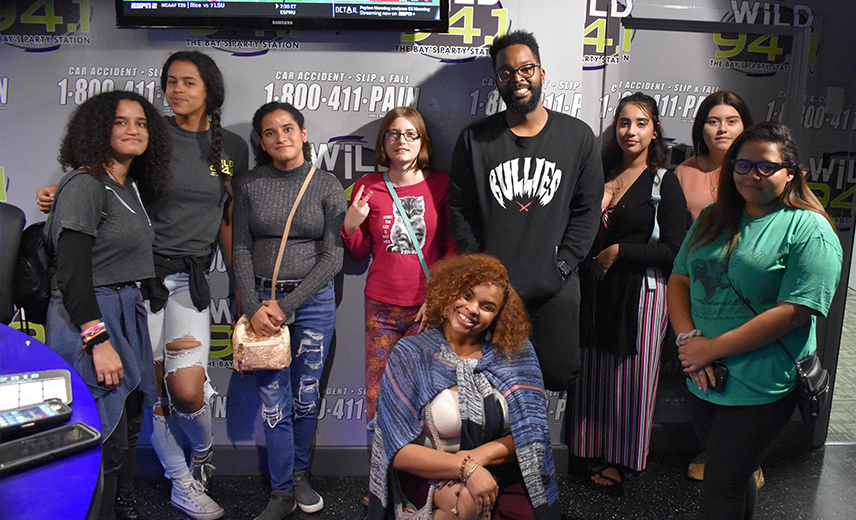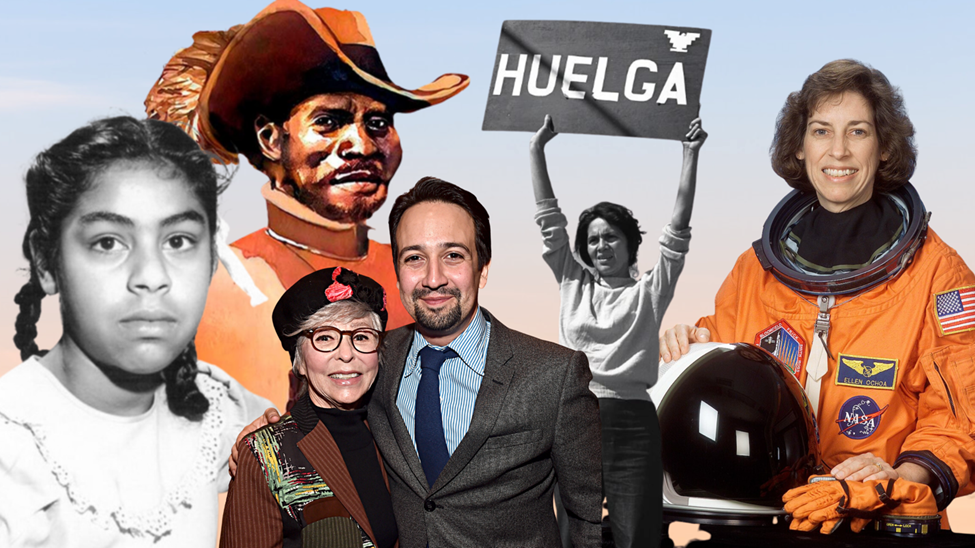It’s International AfroLatinx Women’s Day. Two AfroLatinas Offer Tips for Teaching About Their Identity

Growing up in America, Vanity Duran and Amanda Edgerton felt conflicted about how to identify as Black, Latina women. Now, as educators and youth leaders in Florida, they’re exploring ways to celebrate the whole of their unique identity, paving a more comfortable path for the next generation.
“I never felt like I could say I’m AfroLatina or I’m Blaxican,” says Edgerton, a Teach for America alumni who teaches math to mostly minority students in Jacksonville, Florida. Her mother was Mexican and her father was African American, but she says those identities felt very segregated growing up in California and Georgia. “Even at almost 30, I’m still working on that,” she says. “I definitely didn’t get any help from my school about history. I had to find out stuff on my own.”
Duran is a leader of UnidosUS’s girls empowerment curriculum Entre Mujeres, at its Affiliate organization Enterprising Latinas in Wimauma, Florida. She’ll serve as a panelist next month on an AfroLatinx identity workshop at the UnidosUS Annual Conference. Getting comfortable with these leadership roles wasn’t easy.
Keep up with the latest from UnidosUS
Sign up for the weekly UnidosUS Action Network newsletter delivered every Thursday.
Duran grew up in New Jersey and on Florida’s Gulf Coast as the daughter of Dominicans. Her father had distinguishing African traits, but her mother did not, and since Duran felt that she herself looked Black, she tended to gravitate toward peers identifying as African American but not Latino.
“I grew up listening to hip hop, and a little reggaeton but I felt embarrassed to speak Spanish,” she says. “I had a lot of struggles with my identity because I never really felt Latina enough.”
ProgressReport.co is celebrating International AfroLatinx Women’s Day by asking both Edgerton and Duran for ideas on how to engage all students around this identity. From exploring the beauty of one’s unique physical traits to the beauty of diverse representation in the academic and professional world, these were their top three ideas.

I. Talk to the Hair
Show up in any remote corner of the globe as a foreign-looking person and the kids are bound to reach out and touch your hair. It’s human curiosity. But in today’s more global society, the public is increasingly aware of how uncomfortable and downright political this kind of touch can be for people of African descent. That’s especially true for Black women, who are often pressured to wear their hair in styles deemed acceptable to a society dominated by White, European norms.
Duran says she likes to use hair workshops as an opportunity to educate and build self-esteem among diverse adolescent females because most teenagers spend a lot of time thinking about their identities in terms of their outward appearance. In fact, sometimes Duran brings in a curlologistto guide the discussion or host a full-blown salon party.
“Everyone’s hair gets wavy when its wet. That’s one way of showing us that we’re all one,” says Duran. “Then we can look at different types of textures and curls, and learn to embrace our beauty in our own way.”
During this process, she might ask students to talk about what hair products they use, what ingredients they contain, and what they cost. By doing so, they might consider healthier, more affordable, and organic ways of caring for their hair and their larger self-image.
And while it’s generally considered in poor taste to touch a Black person’s hair, Duran says there are some caveats. For example, an AfroLatina leader or student might offer to have their hair touched while allowing other students to apply the various products or experimenting with hair styles. The important thing is that this activity come from a place of enthusiasm.
“The important thing is a student feels they’re volunteering to be a model to have their hair touched,” she says.

II. All Hail the AfroLatina Queens
Both Duran and Edgerton grew up in schools where educators didn’t point out the connections between Black and Latino cultures. In fact, Duran says it wasn’t until she attended Florida A & M University, an HBCU or Historically Black College and University, that she was able to learn about Africa’s rich, pre-slave trade heritage, and the role that women played in it. She even discovered that most slaves were originally brought through Latin America and the Caribbean.
“It was ike a lightbulb went off in my head,” she recalls. “I grew up always struggling to fit in, so knowing there’s a whole culture out there for me, and for other girls like me really helped a lot,” she says.
For her, one of the best ways to highlight that influence is by identifying famous AfroLatinas, especially ones in the realm of music since most youth like to talk about music. Her all-time favorites are the AfroLatina salserasCelia Cruz of Cuba and Puerto Rico’s contemporary legend La India.
And for Duran, contemporary is key. She says she likes to share reggaeton songs as a way of talking about the intersectionality of musical genres rooted in African, Latin, and other cultures. In those songs, they may find samplings of earlier genres, or a mix of English and Spanish, something that resonates with Duran because she didn’t learn Spanish growing up.
Then there’s the dance moves. Many Latin dance genres stem from earlier African ones, and while it’s true that men generally take the lead in those movements, Duran says this is a great opportunity discuss gender roles and reframe misogynistic attitudes perpetuated by a male-dominated entertainment industry.
“First of all, without women, these men wouldn’t be around,” she says. “In dancing, it might look like the man takes the lead, but the woman gives permission to be spinned or picked up, so it’s really more like teamwork.”

Plus, she says, most of these gutsy moves and dance solos feature women, Duran says this is an opportunity to talk about the beauty, flexibility, and resilience of women’s bodies. This can also build self-esteem by raising important questions about appropriate touch and consent, and recognizing that Latina bodies come in all different colors, shapes, and sizes.

“Not everybody looks like J Lo,” laughs Duran.
And while it’s equally as important to celebrate AfroLatina women who have made other kinds of historic contributions, Duran says she likes the idea of starting with artists because music brings people together, and those AfroLatina entertainers should be recognized as heroes for having broken historic social and political barriers.
“We can teach about the struggles people have had to get that music popularized. There are so many connections in music, and it’s beautiful to hear how the sounds come together,” she says.
She believes that all of these aesthetic experiences can help her students focus better on their studies.
“It will motivate them more to see themselves as deserving of going to school and fulfilling their dreams, she says.
III. Stand and Deliver

As a math teacher, Edgerton doesn’t always have the same freedom to delve deep into long discussions of race, identity, culture, and politics. But she does look for ways to broach those subjects in between lectures on algebra and the meaning of pi.
In fact, she says no matter what topic you may be leading or teaching, it’s important to pause for those opportunities, and the more she does it, the more it relates back to the topic she’s actually teaching.
“I’ve got a strict curriculum, but I’ll do a lot of storytelling – even if it’s just me or the kids sharing our own stories,” she says.

One of those stories is how her Mexican mother was a student in the class depicted in the popular 1988 film Stand and Deliver. In that feature film, Mexican American teacher Jaime Escalante comes to teach math at a predominately working class, Latino high school in Los Angeles where students are performing well below the benchmarks for their grade level. Knowing society has set them up for this situation, he pushes them to reach their full potential, shocking the Educational Testing Service when the students begin raising their scores and signing up for AP Calculus courses.
“My mom was a rebel,” Edgerton says proudly. By that she means her mother defied all kinds of stereotypes about what Latinas should be doing with their lives. By participating in those advanced math courses, she showed a White-centered society that she was smart, engaged, determined, and powerful. By choosing to obtain an education and marry a Black man outside of her family heritage, she showed that she was bold and capable of making her own life choices.
And today, Edgeton stands before the classroom as proof of these powerful experiences. As an AfroLatina woman, she is proof that they too can defy all of society’s stereotypes about who should have what roles. Her personhood is part of a growing body of minority women making inroads in the STEM fields. And so while it’s important that she sets them up for better math scores, she hopes they leave her class each year knowing that questions of identity aren’t always quantifiable and don’t always fit neatly into geometric boxes.
“I want them to leave my class with those intangibles,” she says.


